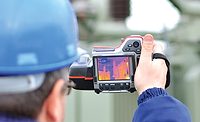Infrared System Ensures Laminate Adhesion
By installing an infrared system, a manufacturer of worktops and laminated panels ensures consistent quality of its product, reducing rejection rates.

Image courtesy of Heraeus Noblelight.
With its in-house CAD design team and extensive workshop facilities, Carella has been producing worktops and laminated systems for over 30 years. These are specified by architects, designers, and contractors for a wide range of applications. Carella worktops, breakfast bars and shower panels are available in many finishes, textures, and styles and are affordable, hygienic, and easy to maintain. Laminated systems can be tailor-made for installation in business centers, shops, and catering areas, as well as multiple applications in the education, healthcare, leisure, hospitality, and science sectors.
The finishing of laminated systems is a relatively simple process. At Carella, cut-to-size panels of chipboard or MDF are manually fed to a PUR hot-melt gluing station, where adhesive is evenly applied to the surface. They then pass to a laminating station where a melamine or Formica sheet is firmly and precisely placed over the panel and glued to it. However, Carella found that when the glue was applied to some panels from storage, the adhesion could be compromised, as glue could become “stringy,” leading to rejection of the finished product.
As the MDF, plywood, and chipboard are stored within the factory building, it was first considered that raising the ambient storage area temperature would provide a solution; this was rejected because through Carella’s investigations, it was determined that the core of the board needed to be heated to help with securing/activating a good bond between the PUR glue and the sheet materials, and this would not be achieved by increasing the ambient temperature in the storage area. The installation of warm air fans was also considered and then rejected because of the associated dust created problems. Eventually, Carella contacted Heraeus Noblelight to see if infrared heating could provide the answer by providing localized targeted heat to the board just before the bonding process began.
Consequently, samples of the base panels were supplied and tests were carried out at Heraeus’s Neston Applications Center. The tests established that medium-wave, carbon infrared would solve the problem. As a result, a 21kW system was installed at Carella’s Eglinton factory in Londonderry, UK. The system is located before the gluing station at a height of 40mm above the thickest board to be heated. When switched on, it operates in stand-by mode at 20% power and then steps up to high power when the board moves from the loading to the laminating station, before returning to stand-by when heating is complete.
The infrared solution has proved to be simple but effective. As Owen Rosborough, production manager at Carella, explains, “We now have much better control of lamination so that there are no adhesion problems, which means that we have consistent quality and fewer rejects. Furthermore, the infrared system has proved to be energy efficient, as it operates only when we need it.”
Heraeus Noblelight carbon emitters have combined the advantages of medium-wave radiation with very fast response times. Carbon IR emitters operate at a wavelength especially suited for materials such as plastics, paper, and textiles. For these materials, as well as for drying and adhesion applications, the carbon emitters achieve a significantly higher efficiency than is possible with short-wave emitters. Consequently, heating processes are much faster and use less energy, resulting in cost savings. The emitters are also ideal for fast-cycle processes since they can be switched on and off in one to two seconds.
Comprehensive tests have shown that carbon emitters dry water-based coatings significantly more efficiently than short-wave infrared emitters. A carbon infrared emitter may require only up to 30% of the energy for the same drying process as a conventional short-wave infrared emitter. Moreover, many materials such as glass and plastics show a decided preference for thermal radiation in the medium-wave region.
Learn more about Heraeus Noblelight at www.heraeus.com/en.
Looking for a reprint of this article?
From high-res PDFs to custom plaques, order your copy today!





